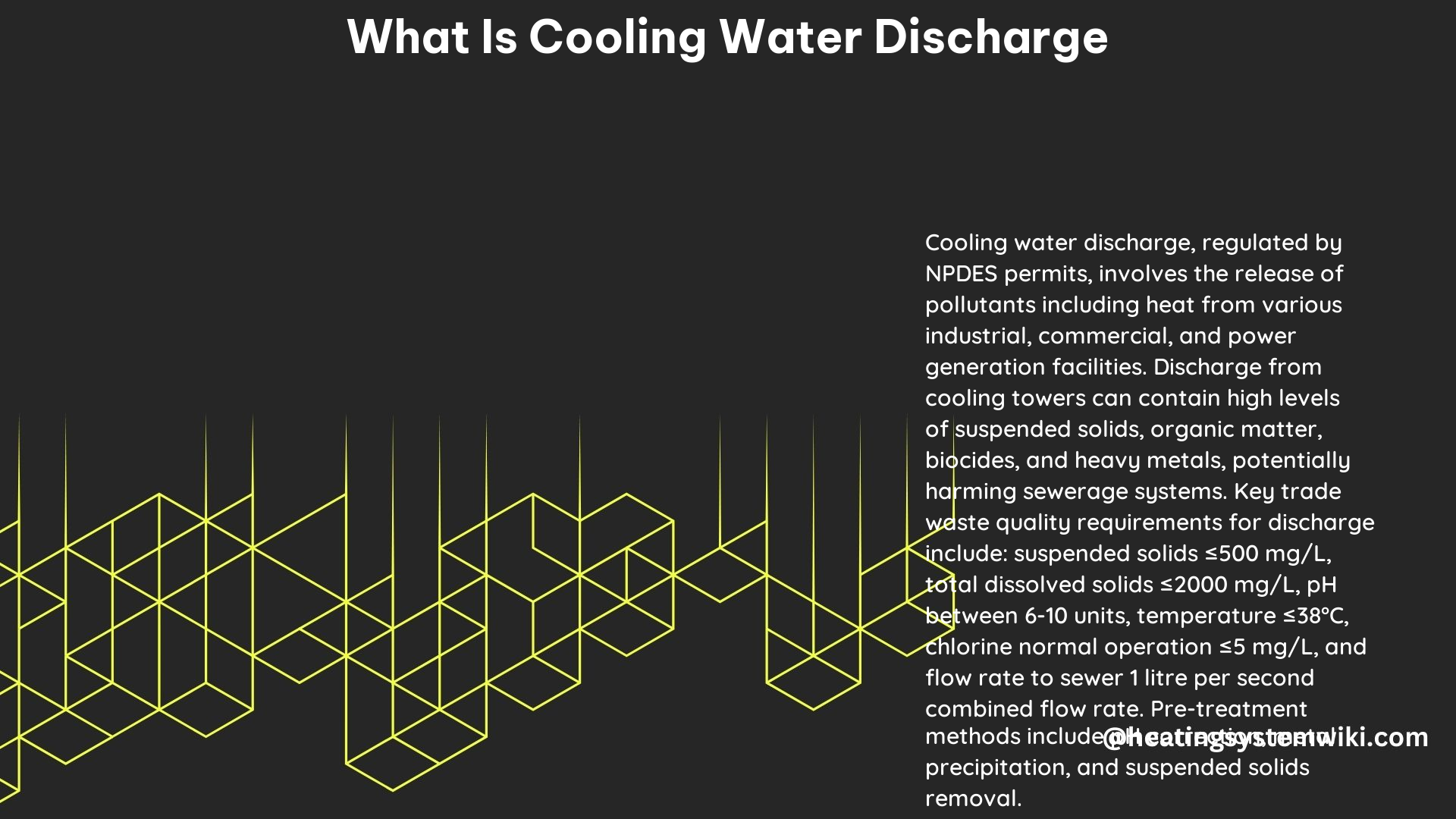Cooling water discharge refers to the removal of water from a recirculating cooling water system, such as a cooling tower, to reduce the buildup of contaminants and maintain efficient heat transfer. This process is necessary because as water evaporates during cooling, it leaves behind minerals and other impurities that can lead to fouling, scaling, and corrosion if not managed properly.
Understanding Cooling Water Discharge
Cooling water discharge, often referred to as “blowdown,” is the process of removing a portion of the circulating water from a cooling tower or other cooling system. This is done to maintain the proper balance of dissolved solids, minerals, and other contaminants in the system.
As water evaporates during the cooling process, it leaves behind these impurities, which can accumulate and lead to several issues, including:
- Fouling: The buildup of deposits on heat transfer surfaces, reducing the efficiency of the cooling system.
- Scaling: The formation of mineral deposits, such as calcium carbonate or silica, which can clog pipes and reduce water flow.
- Corrosion: The degradation of metal components due to the presence of dissolved solids, chemicals, or microorganisms.
To prevent these problems, a portion of the circulating water is discharged, and fresh makeup water is added to the system. This process is known as cooling water discharge or blowdown.
Typical Pre-Treatment Measures

To ensure compliance with regulations and minimize the environmental impact of cooling water discharge, several pre-treatment measures are typically implemented:
- Water and Discharge Flow Meters: Installing meters on the feed line and discharge pipes to monitor water usage and discharge volume.
- Flow Rate Reduction: Reducing the flow rate when draining the cooling tower basin to minimize the impact on the sewerage system.
- pH Correction: Adjusting the pH of the discharge water to within the acceptable range, typically between 6 and 10 units.
- Metal Precipitation: Removing heavy metals from the discharge water through chemical precipitation or other treatment methods.
- Suspended Solids Removal: Removing suspended solids, such as dirt, debris, and organic matter, through filtration or sedimentation.
Regulatory Considerations
In the United States, the Environmental Protection Agency (EPA) has established regulations under the Clean Water Act to protect against pass-through and interference from cooling water discharges. The National Pretreatment Regulation (40CFR 403) was established to protect publicly owned treatment works (POTWs) and the waterways in which they discharge.
Depending on the specific circumstances, a permit under the National Pollution Discharge Elimination System (NPDES) may be required for cooling water discharges. The approval process for NPDES permits takes into account factors such as the location of the cooling tower, availability of sewage treatment, and the potential impact on water quality.
Typical regulatory limits for cooling water discharge may include:
| Parameter | Limit |
|---|---|
| Suspended Solids | ≤500 mg/L |
| Total Dissolved Solids | ≤2000 mg/L |
| pH | 6-10 units |
| Temperature | ≤38 degrees C |
| Chlorine (normal operation) | ≤5 mg/L |
| Chlorine (decontamination) | ≤10 mg/L |
| Flow Rate to Sewer | 1 litre per second combined flow rate, larger flows will be dependent on capacity of receiving sewer |
DIY Cooling Water Discharge Management
To properly manage cooling water discharge and ensure compliance with regulations, consider the following steps:
- Monitor Water Usage and Discharge Volume: Install water meters on the feed line and discharge flow meters on the discharge pipes to track water usage and discharge volume.
- Reduce Flow Rate During Draining: Reduce the flow rate when draining the cooling tower basin to minimize the impact on the sewerage system.
- Install Appropriate Pre-Treatment: Implement pre-treatment measures such as pH correction, metal precipitation, and suspended solids removal before discharging the water to the sewer.
- Regular Testing and Monitoring: Regularly test and monitor the cooling tower water for pH, temperature, and chlorine levels to ensure compliance with regulatory limits.
- Implement a Chemical Water Treatment Program: Develop a well-designed chemical water treatment program to delay the need for cooling tower water bleed-off and minimize the environmental impact of cooling water discharge.
By following these best practices, you can effectively manage cooling water discharge, comply with regulations, and minimize the environmental impact of your cooling system operations.
References:
- Chardon Labs. (2022). Discharge Tower Bleed Sewers. Retrieved from https://www.chardonlabs.com/resources/discharge-tower-bleed-sewers/
- JEA. (n.d.). Cooling Tower Water Discharge | Commercial Best Management Practices. Retrieved from https://www.jea.com/Business_Resources/Industrial_Pretreatment/Commercial_Best_Management_Practices/Cooling_Tower_Water_Discharge/
- SA Water. (2021). Cooling Water Discharge. Retrieved from https://www.sawater.com.au/__data/assets/file/0007/11401/Cooling-Water-Discharge.pdf
- Chardon Labs. (2022). The Basics Of Cooling Tower Discharge – Chardon Labs. Retrieved from https://www.chardonlabs.com/resources/cooling-tower-discharge-basics-bleeding-cooling-towers-epa-npdes-regulation/
- ChemTreat. (n.d.). Cooling Water Systems Fundamentals | Handbook – ChemTreat. Retrieved from https://www.chemtreat.com/water-essentials-handbook-chapter-cooling-water-system-fundamentals/
